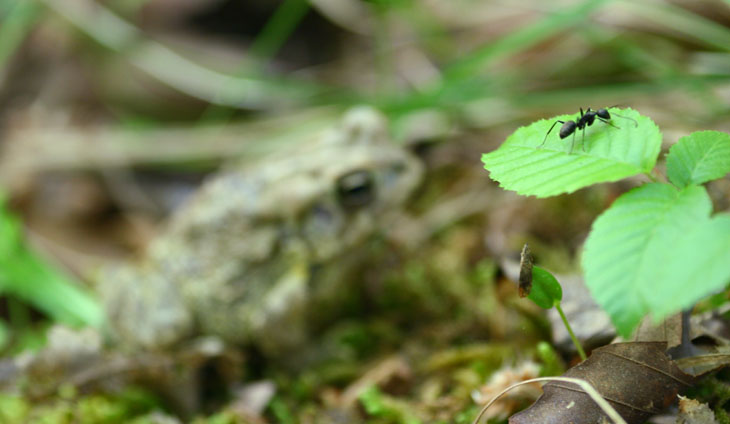
So for today’s topic, let’s talk about good nature photography habits – and bad ones too.
 First off, let me just say that in the time I’ve been doing this blog, both of the species seen here have had their scientific names changed, because I guess taxonomists get bored. Actually, I know it’s because new information regarding relation and genetics and all that is discovered and the changes are made for accuracy, but for those of us who strive to include the scientific names, it does get rather taxing (Ha! Did you catch that? Taxing. Taxonomy. Why am I withering away here when there are all these comedy clubs begging for such talent?) The fellow at top (the one out of focus – I’m being fartsy again) is still an American toad, but now known as an Anaxyrus americanus rather than a Bufo americanus, while the embarrassed dude at right, an Amercian five-lined skink, went from being an Eumeces fasciatus to a Plestiodon fasciatus. Yes, a dude – the red head denotes a male. But notice, they’re both specifically ‘American’ species. What do you wanna bet it’s those Europeans who are provoking these changes?
First off, let me just say that in the time I’ve been doing this blog, both of the species seen here have had their scientific names changed, because I guess taxonomists get bored. Actually, I know it’s because new information regarding relation and genetics and all that is discovered and the changes are made for accuracy, but for those of us who strive to include the scientific names, it does get rather taxing (Ha! Did you catch that? Taxing. Taxonomy. Why am I withering away here when there are all these comedy clubs begging for such talent?) The fellow at top (the one out of focus – I’m being fartsy again) is still an American toad, but now known as an Anaxyrus americanus rather than a Bufo americanus, while the embarrassed dude at right, an Amercian five-lined skink, went from being an Eumeces fasciatus to a Plestiodon fasciatus. Yes, a dude – the red head denotes a male. But notice, they’re both specifically ‘American’ species. What do you wanna bet it’s those Europeans who are provoking these changes?
All of that has nothing to do with habits, however, so let’s get back on track, people. Nearly everyone knows that nature photography takes sharp eyes, but hearing is also important too, especially being alert to the sounds that aren’t typical. Both of these critters were photographed on a recent outing not because I spotted them, but because I heard them as they darted for cover. Neither was particularly loud either – both times the sounds were the faint rustle of leaves as I approached. By looking immediately down at the sounds as they occurred, I caught the flash of movement which pinpointed their position even as they stopped moving to count on their camouflage.
The other example of this came up several times today, once even as I was writing this post. The windows are open, and scatterings of birdsong can be heard at just about any time, including the mad demands of fledglings from the nest box just outside the window. But at times, the bird calls would get frantic and quite close, with several different species taking part, most noticeably the sharp chirp of the robin’s alarm call. This prompted me to go out armed with the long lens. After this failed to be of any use, I attached a camera to it.
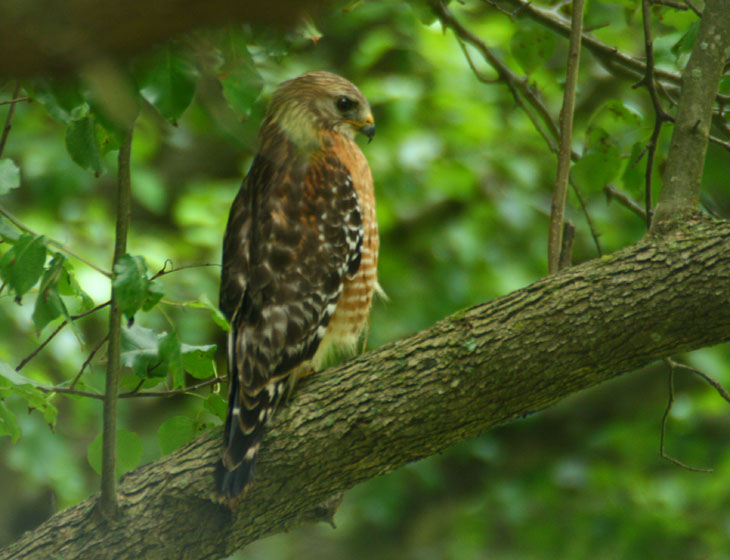
I got several glimpses without enough to identify it, but the protective songbirds kept pinpointing its location, and I finally got a good enough view to peg it as a red-shouldered hawk (Buteo lineatus.) This was no surprise, since I’ve seen them countless times in the area and hear their territorial calls often, a repeating cry that sounds rather forlorn. But the way it was staying down low and cutting between houses, I was suspecting a bird-hunting accipiter, like a Cooper’s or sharpshinned hawk. It’s also a good habit to know what the local species are like, where they live, how they behave, and so on – this can (sometimes, anyway) help establish what you might be seeing.
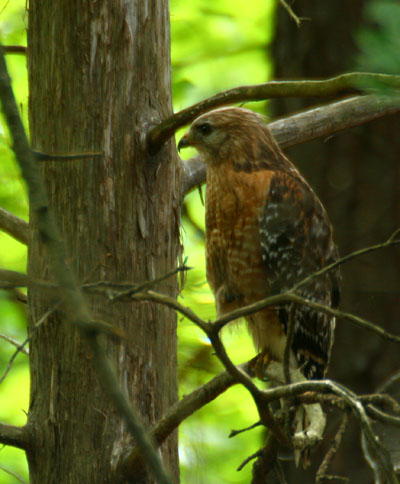 Now, I may be partially to blame for the hawk’s behavior here, though wholly without intention. I have been working on a small pond in the backyard, partially ornamental, partially to attract photo subjects. It’s far from done, but I’ve placed the pond liner and filled it with water to get it settled in place, adding a filter to help control its use as a mosquito breeding ground. A few days back, I was made aware that it was already serving its purpose when I heard a loud plop as I approached, quickly determining that we now had a resident frog – I took it to be a leopard frog at first, but the markings indicate that it’s a green frog instead. I think it’s going to be one of those days – green frogs used to be Rana clamitans, but are now Lithobates clamitans…
Now, I may be partially to blame for the hawk’s behavior here, though wholly without intention. I have been working on a small pond in the backyard, partially ornamental, partially to attract photo subjects. It’s far from done, but I’ve placed the pond liner and filled it with water to get it settled in place, adding a filter to help control its use as a mosquito breeding ground. A few days back, I was made aware that it was already serving its purpose when I heard a loud plop as I approached, quickly determining that we now had a resident frog – I took it to be a leopard frog at first, but the markings indicate that it’s a green frog instead. I think it’s going to be one of those days – green frogs used to be Rana clamitans, but are now Lithobates clamitans…
Within a day or so, I determined that we had two, one of which was exceedingly mellow and would often sit at the pond’s edge without moving, even as I did yard work very close by, or when I moved in for a tight portrait. Such habits can be very helpful to nature photographers, but aren’t exactly the kind of trait that any wildlife should develop. You see, one of the dietary staples of a red-shouldered hawk is frogs…
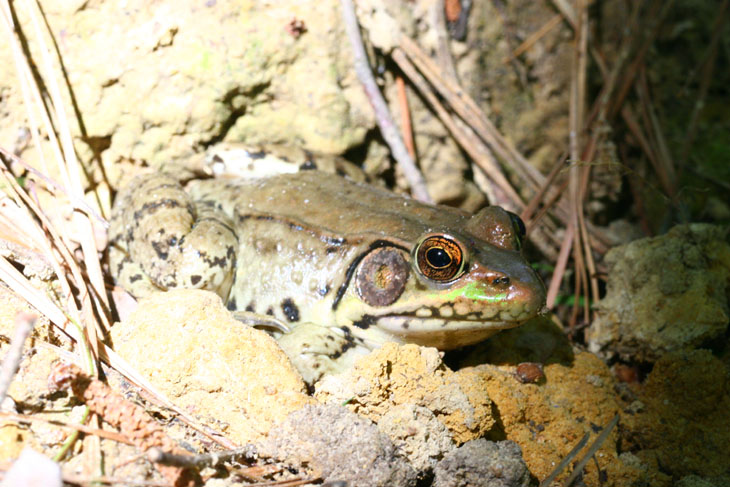
In fact, I first heard the frenetic alarm calls of the local birds yesterday, and went out onto the back porch to see the hawk take off from the ground right near the pond, clutching something. It looked bigger than this frog, but then again, I haven’t seen it since. But now the hawk has been doing a lot of flying around at low level within the tree canopy of the immediate area, so I think that, in a rather indirect way, I fostered this behavior of the hawk. We have three occupied nest boxes on this property alone, two titmouse and one chickadee nest, and who knows how many robin’s nests up higher; none of them are happy with this development themselves, since red-shouldered hawks will also eat baby birds.
So now, on to my bad habits.
 On an excursion to the river the other day with the unimpeachable Al Bugg, one of the things I was keeping an eye out for, again, were the snakes. Surprisingly, we’d been out for a couple of hours before I spotted a 1.5 meter black rat snake (Elaphe obsoleta– no, goddammit, it’s now a Pantherophis obsoleta. I mean, come on!) Now, I know wildlife should be left alone and not disturbed, but I’m rather bad about snakes; if I can capture them, I often will, just to examine them, and will take any given opportunity to demonstrate to anyone who should be around that few species present the faintest danger. If they appear to have eaten recently, or are engaged in amorous pursuits or things of that nature, I’ll leave them be, but if there seems little chance of interrupting them during crucial times I often won’t hesitate. The rat snake was quite mellow, as they often are, and made no attempt to bite, so we did a quick photo opportunity. And yes, I’m working on getting Mr. Bugg to dress more appropriately for stalking wildlife – he’s a UNC fan and often wishes to make this unmistakable.
On an excursion to the river the other day with the unimpeachable Al Bugg, one of the things I was keeping an eye out for, again, were the snakes. Surprisingly, we’d been out for a couple of hours before I spotted a 1.5 meter black rat snake (Elaphe obsoleta– no, goddammit, it’s now a Pantherophis obsoleta. I mean, come on!) Now, I know wildlife should be left alone and not disturbed, but I’m rather bad about snakes; if I can capture them, I often will, just to examine them, and will take any given opportunity to demonstrate to anyone who should be around that few species present the faintest danger. If they appear to have eaten recently, or are engaged in amorous pursuits or things of that nature, I’ll leave them be, but if there seems little chance of interrupting them during crucial times I often won’t hesitate. The rat snake was quite mellow, as they often are, and made no attempt to bite, so we did a quick photo opportunity. And yes, I’m working on getting Mr. Bugg to dress more appropriately for stalking wildlife – he’s a UNC fan and often wishes to make this unmistakable.
It wasn’t the rat snakes that I was expecting to find, especially not swimming along the rocks even though they’re perfectly comfortable with this, but the water snakes instead. We’d spotted a small queen snake (Regina septemvittata) early on, but I was after the more impressive species. Eventually, I came across one sprawled among the rocks in a rather obtrusive way. Once again, not a good habit here – too far from protective water and a very inviting target for hawks and herons.
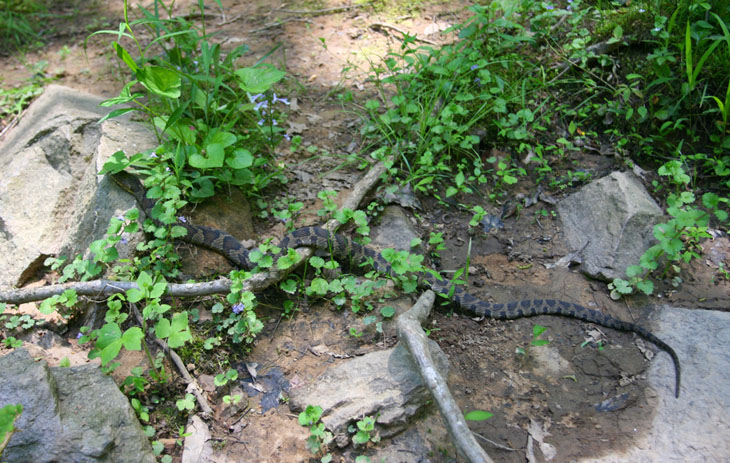
Once again, this is a northern water snake (Nerodia sipedon – still,) not quite a meter long; not huge but certainly noticeable. I was able to lean in pretty close without it getting spooked, which was a bit curious given how fast the ones at the closest pond will hurtle away before I can even see their heads.

This one didn’t quite let me get close enough to do a self-portrait in the reflection within the eye, but not far from it either, and it was certainly aware of my presence. Eventually it decided discretion might be a good thing after all, and it made quickly for the water – as quickly as it could, being four meters or so away among the rocks, anyway. We watched, and it swam straight out completely across the river, probably about eight or nine meters at that point. We moved on.
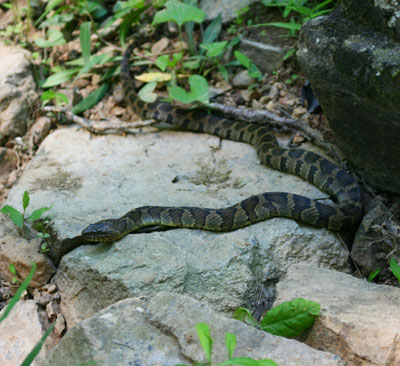 On the return leg a half-hour later, I pointed out the spot as we passed it, and was asked if we would see the same snake. My answer was negative, because we’d spooked it enough to make it think the area was hazardous, and besides it had crossed over. So much for my behavioral predictions. This was waiting about three meters from where we’d had the first encounter.
On the return leg a half-hour later, I pointed out the spot as we passed it, and was asked if we would see the same snake. My answer was negative, because we’d spooked it enough to make it think the area was hazardous, and besides it had crossed over. So much for my behavioral predictions. This was waiting about three meters from where we’d had the first encounter.
I’ve compared several of the markings in the photographs and am quite sure it was the exact same one, not to mention that it still had that brightness from being damp. This time around, I was able to block it off from escaping, and picked it up, not quite getting the grip right behind the head that I’d wanted to, at least at first.
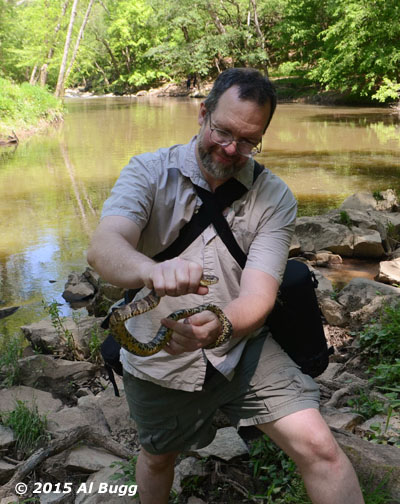 My grip is not half as fierce as this photo makes it seem – basically, firm enough to prevent it from escaping but not even enough to prevent it from squirming. I mentioned before that this species is aggressive, and because I didn’t initially grab it where I should’ve, it was able to demonstrate this trait nicely, biting me three times as well as smearing my forearm with feces (a very common defensive act of snakes, as well as a few other species.) Snake teeth are sharp but ridiculously short, only used for gripping in the non-venomous species, so there was blood as proof, but that’s about all. Snake shit, on the other hand, has a very distinctive odor and does not go away easily, so I received the benefit of that until I got home.
My grip is not half as fierce as this photo makes it seem – basically, firm enough to prevent it from escaping but not even enough to prevent it from squirming. I mentioned before that this species is aggressive, and because I didn’t initially grab it where I should’ve, it was able to demonstrate this trait nicely, biting me three times as well as smearing my forearm with feces (a very common defensive act of snakes, as well as a few other species.) Snake teeth are sharp but ridiculously short, only used for gripping in the non-venomous species, so there was blood as proof, but that’s about all. Snake shit, on the other hand, has a very distinctive odor and does not go away easily, so I received the benefit of that until I got home.
People always ask, “Are you sure it’s not poisonous?” Yes, I’m sure. The markings are not even close to a copperhead, and those stripes along the lower jaw (seen very well above) distinguish it from a cottonmouth – which aren’t found much in this area at all (like, only once confirmed.) Those are the only two venomous (not poisonous) snakes in this region. Moreover, the habitat is what water snakes prefer, which includes the cottonmouth, but not at all what copperheads prefer; another aspect is simply knowing what is likely to be found in any given terrain. I think everyone should see examples of the local species early on, especially side-by-side if possible, so they feel comfortable telling them apart. There are far too many overboard reactions to snakes around here, especially considering the trivial risk – dicking around with your toy phone in the car is hundreds of times more dangerous.
 Unfortunately, the autofocus wandered to the background on Mr. Bugg for this shot, and he didn’t get any others for security, so the detail is lacking here, but you’re seeing the horrendous damage to my hands from the bites. Actually, you can only see one, the slow-oozing blood on the middle finger of the right hand; there’s another bite on the base of the left thumb, which is why I’m holding my hands close together like that, but with the focus off you can’t even make out the tiny red spots. I did more damage to myself working in the yard earlier. In other words, big fat hairy deal, and this was with a provoked bite. Had I not grabbed it, it might have happened only if I’d stepped on it instead.
Unfortunately, the autofocus wandered to the background on Mr. Bugg for this shot, and he didn’t get any others for security, so the detail is lacking here, but you’re seeing the horrendous damage to my hands from the bites. Actually, you can only see one, the slow-oozing blood on the middle finger of the right hand; there’s another bite on the base of the left thumb, which is why I’m holding my hands close together like that, but with the focus off you can’t even make out the tiny red spots. I did more damage to myself working in the yard earlier. In other words, big fat hairy deal, and this was with a provoked bite. Had I not grabbed it, it might have happened only if I’d stepped on it instead.
As for my interruption of its ‘natural’ behavior or whatever? First of all, humans are as natural as hawks, so any distinctions in such a topic are arbitrary, period. Second, considering the large number of people that would kill it, throw rocks at it, let their fucking unleashed dogs at it, and so on, we’re not talking serious impact from handling. And then there’s getting eaten by hawks, which is frequent and typical. If I convinced this one to be a little less blasé about where it sits and how close an approach it permits, that could very well be all for the better. Judge me as you wish.




















































